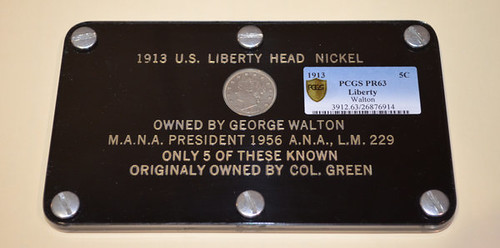
PREV ARTICLE
NEXT ARTICLE
FULL ISSUE
PREV FULL ISSUE
NEW YORK TIMES ARTICLE HIGHLIGHTS WALTON 1913 LIBERTY NICKEL
It can be interesting to read the mainstream press' take on the numismatic hobby. Here's an excerpt from article from The New York Times about the upcoming sale of the Walton specimen of the 1913 Liberty Nickel.
-Editor

On the rainy night of March 9, 1962, a head-on car crash scattered a quarter-million dollars’ worth of coins across a North Carolina highway, and the life story of a solitary collector named George O. Walton came to an end. But another story began — one of expert blunders, abiding family loyalty and long-awaited redemption. Lying on the wet asphalt that night, in a custom holder that Mr. Walton had had made for it, was the object that connected those two stories: a 1913 Liberty head nickel, a coin that was never meant to be, with its own enduring tale as one of America’s greatest rarities. The year after Mr. Walton died, his heirs were given shocking news: experts in New York had decreed the nickel a worthless fake. Mr. Walton’s sister put it away in her closet, but the family never lost faith in their Uncle George’s legacy. On April 25, at an auction in Chicago, that loyalty is expected to be rewarded. Now recognized as authentic, Mr. Walton’s nickel is expected to fetch $2 million to $5 million. Mr. Walton’s nephew, Ryan Givens, of Roanoke, Va., described his uncle as a bluntly forthright Southerner who was largely self-educated. “He was not a bragger, but he enjoyed talking to people about his coins. He liked matching wits with others and trading,” said Mr. Givens, who last saw his uncle at a family gathering a few weeks before the car crash. Though intensely private, Mr. Walton was “good at finding things,” learned quickly from mistakes and enjoyed the camaraderie of his fellow collectors. Mr. Walton had an odd knack for collecting coins. His grandfather had encouraged him to collect the nickels he earned tending horses. As a teenager, Mr. Walton bet a group of schoolmates a coonskin against their gold dollar that he could beat them in wrestling. He won, and his appetite for gold was whetted. Later on, his prized possessions included a set of early gold coins minted in the Carolinas by the Bechtlers, a family of 19th century metallurgists. According to Mr. Givens, his uncle was also an astute trader. In the mid-1940s, he swapped another collector $3,750 worth of collectible gold coins for the 1913 Liberty head nickel, which was already legendary. Mr. Walton was never a rich man, but his work as an estate appraiser often allowed him to get first crack at collectibles. His collecting passion extended to stamps, books, jewelry, Civil War memorabilia and guns. He accumulated so many vintage firearms that he had to buy another house just to store them, Mr. Givens said, and would often use his collections as collateral for bank loans to acquire more. Though he owned several houses, Mr. Walton lacked a fixed abode. “Nobody knew where he was at any given time,” Mr. Givens said. Instead, Mr. Walton kept his coins in safe deposit boxes, lived mostly in hotels, and traveled about in his 1956 Ford station wagon, visiting favorite dealers and showing up at coin exhibits and weekend bourses. He was on his way to a collector event in Wilson, N.C., to show his famous nickel on the night he died.
The article goes on to discuss the origin of the nickels and their passing through the hands of our good friend Eric Newman.
-Editor
Though he was evasive about their provenance, Mr. Brown sold all five nickels and they wound up together in the hands of Col. Edward H. R. Green, a famous collector with an insatiable appetite for all things unusual. After Colonel Green died, a young collector named Eric P. Newman teamed up with a dealer in 1941 to buy many of Colonel Green’s coins, including the five 1913 Liberty head nickels. In an e-mail, Mr. Newman said that later that same year, he resold the coin that would eventually come into Mr. Walton’s collection. Besides Mr. Walton’s heirs, “I believe that I am the only survivor of its various owners,” wrote Mr. Newman, now 101. “I am so lucky to have lived so long.” It was Mr. Newman’s research that led to the discovery that Mr. Brown had been a mint employee in 1913, and might have illicitly produced the instant rarities himself. Mint records show no such coin was ever officially made. To read the complete article, see: Once-Maligned Coin Nears Its Big Payday (www.nytimes.com/2013/04/15/us/1913-liberty-head-nickel-is-expected-to-fetch-millions.html)
THE BOOK BAZARREWayne Homren, Editor The Numismatic Bibliomania Society is a non-profit organization promoting numismatic literature. See our web site at coinbooks.org. To submit items for publication in The E-Sylum, write to the Editor at this address: whomren@gmail.com To subscribe go to: https://my.binhost.com/lists/listinfo/esylum All Rights Reserved. NBS Home Page Contact the NBS webmaster 
|